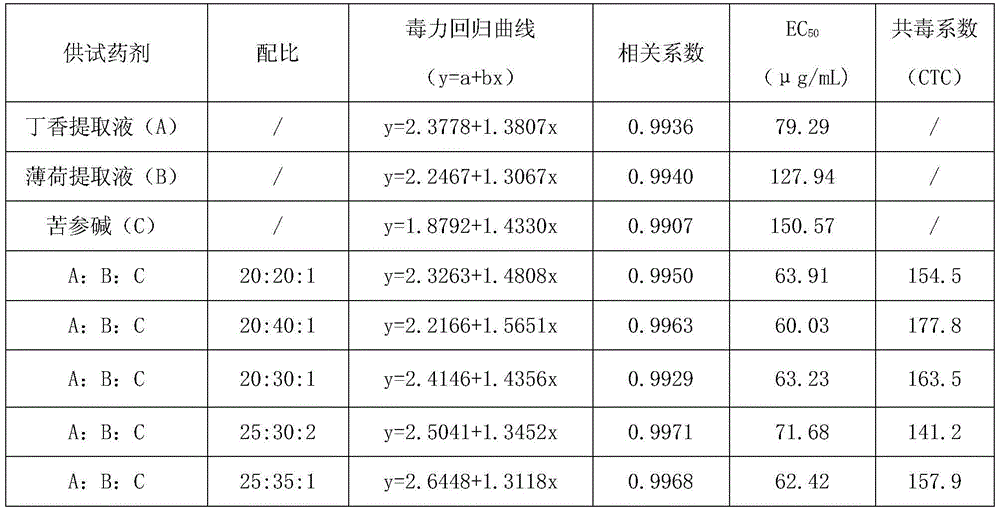Botanical disinfection deodorant
A deodorant and plant-sourced technology, applied in the direction of disinfectants, plant growth regulators, deodorization, etc., can solve the problems of large damage to residents' lives, secondary pollution of the environment, and inability to repel mosquitoes and flies, and achieve the goal of repelling aggregation damage , high control efficiency, and the effect of reducing the breeding and transmission of germs
- Summary
- Abstract
- Description
- Claims
- Application Information
AI Technical Summary
Problems solved by technology
Method used
Image
Examples
Embodiment 1
[0021] Example 1: Indoor Toxicity Determination of Clove Extract, Peppermint Extract, Matrine and Their Mixtures to Aspergillus flavus
[0022] After pretesting to determine the effective inhibitory concentration range of each extract, the clove extract, peppermint extract, matrine and their mixtures were treated with 5 dose gradients according to the content of active ingredients, and a clear water control was set. Refer to the "Pesticide Indoor Bioassay Test Guidelines for Fungicides", and use the mycelium growth rate method to determine the toxicity of the agent to Aspergillus flavus. After 72 hours, the colony diameter was measured by the cross method, and the net growth rate of each treatment was calculated for mycelial growth inhibition rate.
[0023] DPS data processing software was used for statistical analysis, the mycelia growth inhibition rate was converted into a probability value (y), the concentration of the drug solution (μg / mL) was converted into a logarithmic ...
Embodiment 2
[0028] Example 2: 6.1% Clove Extract · Peppermint Extract · Matrine Plant Source Deodorant
[0029] Add 2.0% clove extract, 4.0% peppermint extract, 0.1% matrine, 1.5% polyvinylpyrrolidone, 2.5% fatty acid polyoxyethylene ester, make up the remaining water to 100%, stir well and mix evenly at room temperature, and prepare A plant-derived deodorant consisting of 6.1% clove extract, peppermint extract, and matrine.
[0030] This embodiment is applied to the deodorization test of municipal solid waste. Monitoring conditions: Put a pile of about 200kg of highly rotten domestic garbage that produces stench in a closed room of 12m×5m×3.5m, and arrange 3 sampling points evenly at about 0.6m around the garbage, and the heights of the sampling points from the ground are respectively For 0.8m, 1.2m, 1.6m, use the deodorant agent mixed with 80 times of water to spray evenly on the surface of the garbage. The surface is thoroughly wetted as the standard, and then spray again at intervals...
Embodiment 3
[0036] Example 3: Field test of 5.7% clove extract · peppermint extract · matrine applied to urban domestic waste
[0037] Add 2.5% of clove extract, 3.0% of mint leaf extract, 0.2% of matrine, 2.5% of sodium dodecylbenzenesulfonate, 2.5% of polyvinylpyrrolidone, and make up the rest to 100% with water, mix well at room temperature , that is, a plant-derived deodorant made of 5.7% clove extract, peppermint extract, and matrine.
[0038]The garbage dump site in Yunbiao Town, Hengxian County, Nanning City, Guangxi was selected for field experiments, and the Nanning Environmental Sanitation Testing Center was entrusted to test the concentration of odor-related components and the total number of bacteria in the garbage. Before spraying, measure the concentration of relevant components and the total number of bacteria in the garbage odor, and then dilute the prepared deodorant agent by 80 times, and spray evenly on the surface of the garbage, taking the surface as the standard. Me...
PUM
| Property | Measurement | Unit |
|---|---|---|
| diameter | aaaaa | aaaaa |
Abstract
Description
Claims
Application Information
 Login to View More
Login to View More - R&D
- Intellectual Property
- Life Sciences
- Materials
- Tech Scout
- Unparalleled Data Quality
- Higher Quality Content
- 60% Fewer Hallucinations
Browse by: Latest US Patents, China's latest patents, Technical Efficacy Thesaurus, Application Domain, Technology Topic, Popular Technical Reports.
© 2025 PatSnap. All rights reserved.Legal|Privacy policy|Modern Slavery Act Transparency Statement|Sitemap|About US| Contact US: help@patsnap.com



